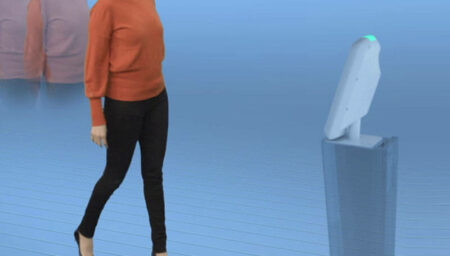Checking identities quickly with face and iris capture using OneLook™ Gen2

Over the last few years, the use of biometric identification has become commonplace, with many government and private sector entities integrating biometric systems into their infrastructures. Biometrics are frequently used to unlock apps and devices, but they are also used to verify a person’s identity when they apply for a passport, open a bank account, board a plane, or vote—the list is endless.
Three of the most popular biometrics currently used are face, fingerprints, and iris. Iris recognition is widely considered to be one of the safest and most accurate methods of biometric identification. Contrary to a person’s hands and face, the iris is a protected internal organ and is therefore less likely to be damaged. It can safely be used on children as young as four years old. Iris data from over one billion people has been collected for the Aadhaar Unique Identity program in India. Iris identity verification is also used at the United Arab Emirates’ air and sea ports.
A camera captures photos of a person’s eyes and maps the unique iris pattern to verify their identity. The random texture of an iris is complex, distinctive, resistant to aging, and virtually impossible to replicate which enables iris data to act as an identifier that is unique for each individual. The randomness of an iris pattern means that it has very high dimensionality. This means that recognition decisions can be made with utmost confidence.
To demonstrate that the iris does not age, let us consider a famous example—we all remember “Afghan Girl” with her striking eyes on the front cover of the June 1985 edition of National Geographic. 18 years after taking her photo, photojournalist Steve Curry set out on a mission to find her again. A team from National Geographic Television & Film’s EXPLORER found her in the mountains near Tora Bora, Afghanistan, but needed reliable evidence that this person really was “Afghan Girl”. By using advanced iris recognition techniques, Professor John Daugman was able to confirm that Sharbat Gula was indeed “Afghan Girl”¹.
Iris data can also be used to differentiate between identical twins with complete certitude, despite their DNA being the same. The left and right eyes of the same person are likewise completely different. Because no two iris patterns are the same, the false acceptance rate is extremely low. The entropy2 of the iris recognition algorithm is as high as 240 bits, keeping in mind that 33 bits are enough to discriminate between the entire human population.
The iris data is free from gender and ethnic bias. Nothing except the detail of the iris pattern is taken into account when verifying a person’s identity. Information around the iris, such as the shape of the external eye or whether or not the person is wearing makeup, is not taken into account. Also, since all iris recognition images are captured in infrared, the color of the person’s eye is completely irrelevant.
A person simply looks into a camera for a few seconds to complete the verification check. Glasses and contact lenses are completely transparent and therefore have no impact on iris recognition. The process consists in capturing a video image—it is non-invasive and inherently safe. Eyes are self-cleaning and image capture is performed without physical contact, making iris capture a safe and hygienic option. Furthermore, people do not leave a physical or digital trace of their iris which significantly limits the danger of spoofing.
Iris recognition systems have very low maintenance costs. They have seamless interoperability between different hardware vendors and work well with a wide range of applications.
IDEMIA, the global leader in Augmented Identity, has created OneLook™: a non-intrusive solution that offers accurate iris data capture and on-the-spot identity verification. OneLook™ is a rare solution on the market that is able to capture a person’s iris at a distance, even when the individual is on the move. In 2020, IDEMIA’s algorithms ranked number one in the IREX 10: Identification Track of the NIST benchmark assessing iris recognition performance for identification.
IDEMIA has also created a mobile solution that includes iris recognition and can easily be used on-the-go for law enforcement, border control, civil enrollment, elections, etc. The tablet enables high-speed authentication and a triple-check verification using either on-device capabilities or connection to remote servers—making it a powerful tool to combat fraud.
Iris recognition is a more secure and reliable method of verifying a person’s identity than merely through the possession of documents and/or codes which makes it a key technology for a wide range of applications.
1 https://www.cl.cam.ac.uk/~jgd1000/afghan.html
2 A way of measuring the lack of order that exists in a system